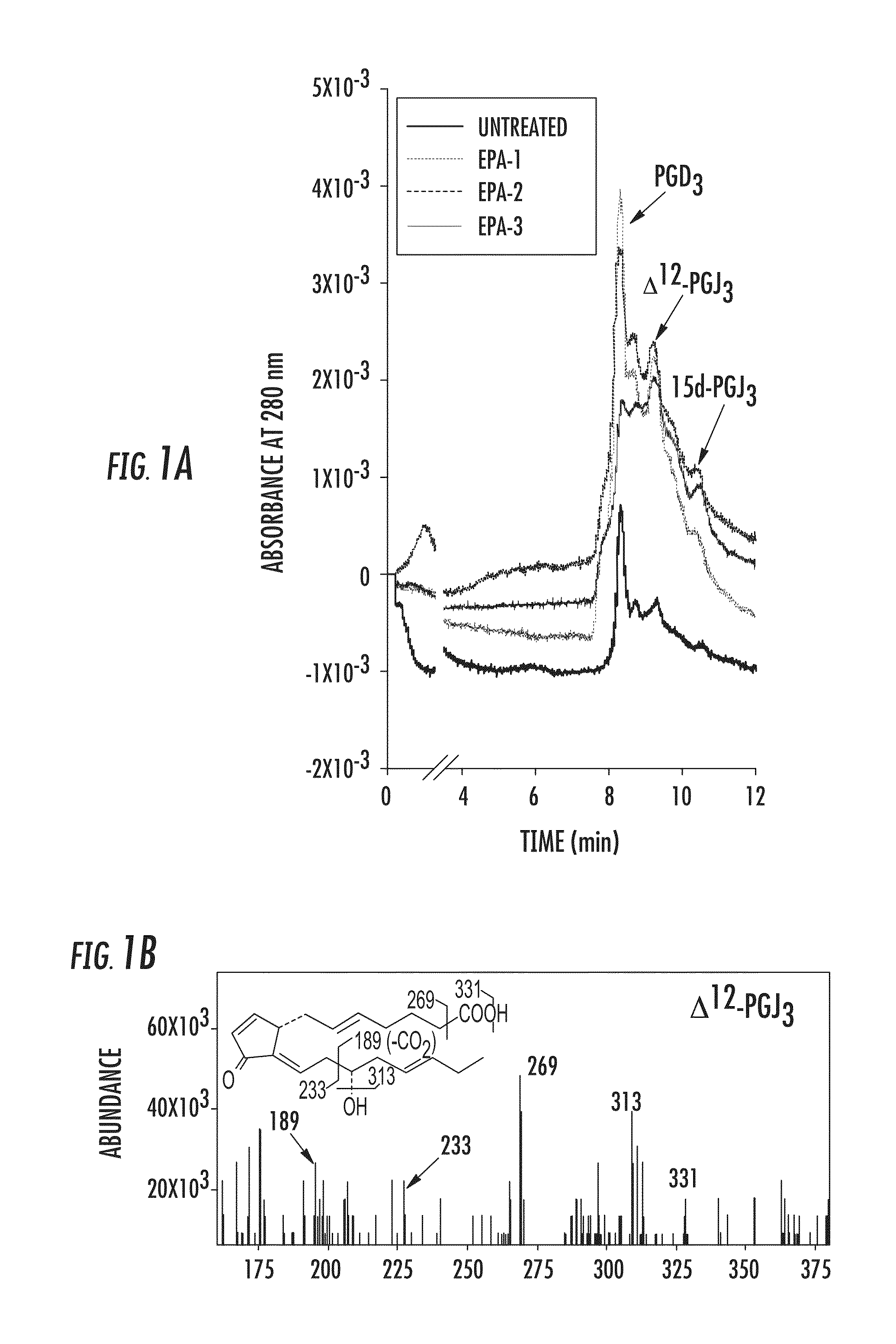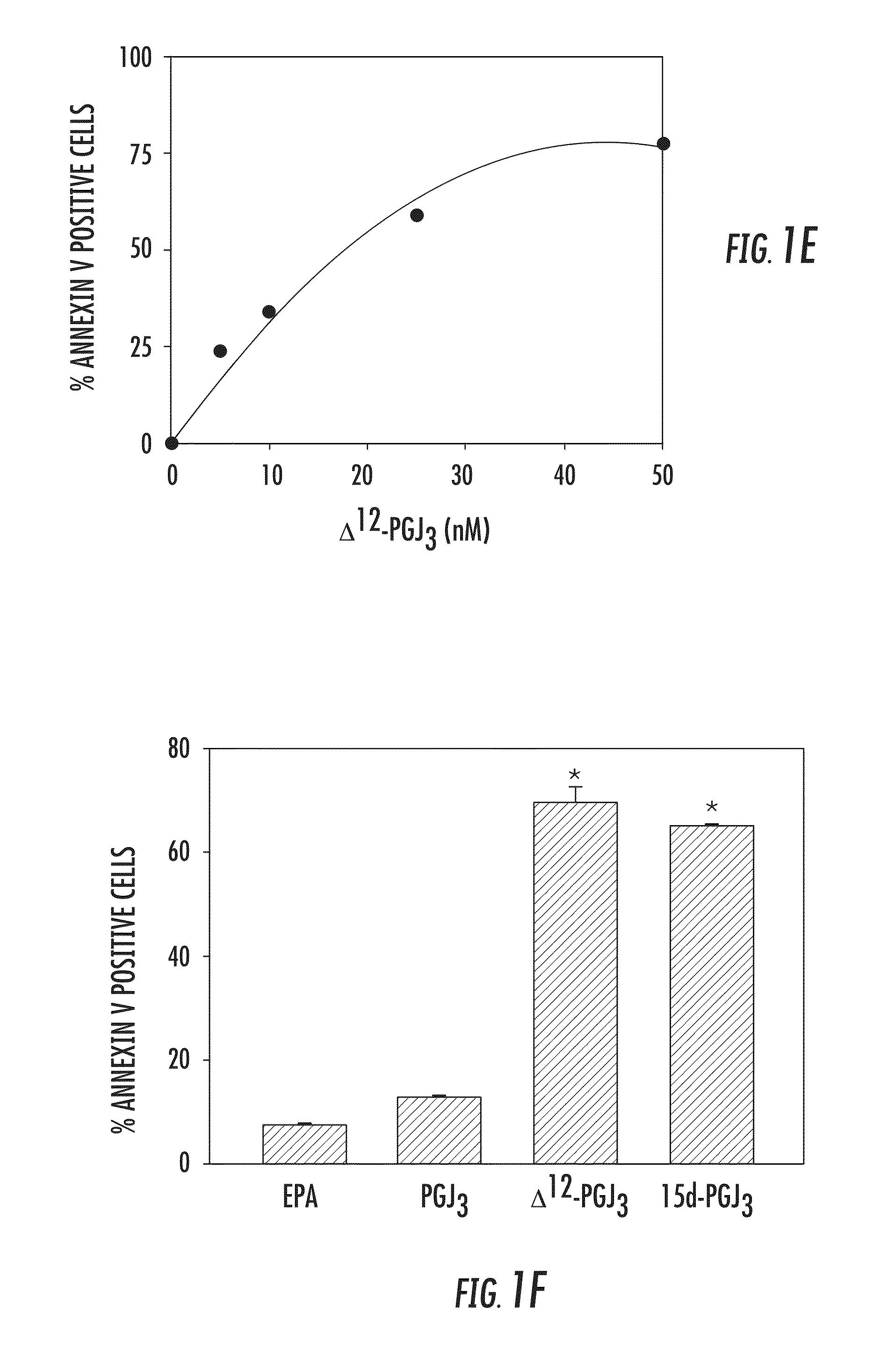Compositions, methods and kits for treating leukemia
- Summary
- Abstract
- Description
- Claims
- Application Information
AI Technical Summary
Benefits of technology
Problems solved by technology
Method used
Image
Examples
example 1
Δ12-Prostaglandin J3, an Omega-3 Fatty Acid-Derived Metabolite, Selectively Ablates LSCs in Mice
[0065]The endogenous formation of Δ12-PGJ3 from EPA was investigated and the ability of this novel n-3 PUFA metabolite to target LSCs was examined in two well-studied models of leukemia, Friend Virus (FV)-induced erythroleukemia (Ben-David Y & Bernstein A, Cell. 1991; 66:831-834) and a well-established model for inducing CML in mice, which utilizes BCR-ABL-IRESGFP retrovirus (Schemionek M et al., Blood. 2010; 115:3185-3195; Pear W S et al., Blood. 1998; 92:3780-3792; Hu Y et al., Proc Natl Acad Sci USA. 2006; 103:16870-16875; Zhao C et al., Nature. 2009; 458:776-779), wherein transplantation of transduced HSCs into mice results in pathology similar to the chronic phase of CML. FV-induces leukemia by activating the bone morphogenetic protein-4 (BMP4)-dependent stress erythropoiesis pathway, which leads to a rapid amplification of target cells and acute disease (Subramanian A et al., J. Vir...
example 2
Targeting LSCs Via Molecules that Activate DP
[0101]The data shown in FIGS. 8 and 9 suggests a role of a class of G-protein coupled receptors (called DP), which play a role in the apoptosis of LSCs by Δ12-PGJ3. In addition, experiments were performed with synthetic agonists of the receptor as well.
[0102]Referring to FIG. 8, this data shows that imatinib-resistant BCR-ABL(GFP)+ cells are targeted by Δ12-PGJ3. In this experiment, mice were transplanted with BCR-ABL+LSCs and a week later imatinib treatment was initiated by i.p. for 1 wk at 25 mg / kg / day. After a 1 week washout period post imatinib treatment, spleens were dissected and the total splenocytes were treated ex-vivo with 25 nM Δ12-PGJ3 or vehicle (PBS) for 24 h. GFP+LSCs were analyzed by flow cytometry. As shown in FIG. 8, Δ12-PGJ3 treatment can even target LSCs that are resistant to imatinib treatment.
[0103]An experiment was performed that showed apoptosis of BCR-ABL+LSCs by Δ12 PGJ3 is inhibited by synthetic antagonists of t...
example 3
Δ12-PGJ3 and related agonists do not affect normal human hematopoiesis
[0105]Referring to FIG. 10, this graph shows that Δ12-PGJ3 and related agonists do not affect normal human hematopoiesis. In an experiment described above, the data showed the effects of Δ12-PGJ3 on the formation of terminally differentiated hematopoietic cell colonies. These colonies are called colony forming cells or CFC. For that experiment, only growth factors necessary for multilineage myeloid colony formation were added. Referring to FIG. 10, media containing multiple growth factors supplemented with the compounds listed on the X axis of the graph was used. Δ12-PGJ3 had no effect. The synthetic DP agonist ZK also had no effect. In conclusion, Δ12-PGJ3 and related agonists do not affect normal human hematopoiesis.
[0106]Referring to FIG. 11, Δ12-PGJ3 does not affect the ability of normal bone marrow cells to differentiate (to form BFUe). In this experiment, human bone marrow cells (CD34+; Reach Bio, Seattle, W...
PUM
| Property | Measurement | Unit |
|---|---|---|
| Electrical resistance | aaaaa | aaaaa |
Abstract
Description
Claims
Application Information
 Login to View More
Login to View More - R&D
- Intellectual Property
- Life Sciences
- Materials
- Tech Scout
- Unparalleled Data Quality
- Higher Quality Content
- 60% Fewer Hallucinations
Browse by: Latest US Patents, China's latest patents, Technical Efficacy Thesaurus, Application Domain, Technology Topic, Popular Technical Reports.
© 2025 PatSnap. All rights reserved.Legal|Privacy policy|Modern Slavery Act Transparency Statement|Sitemap|About US| Contact US: help@patsnap.com



